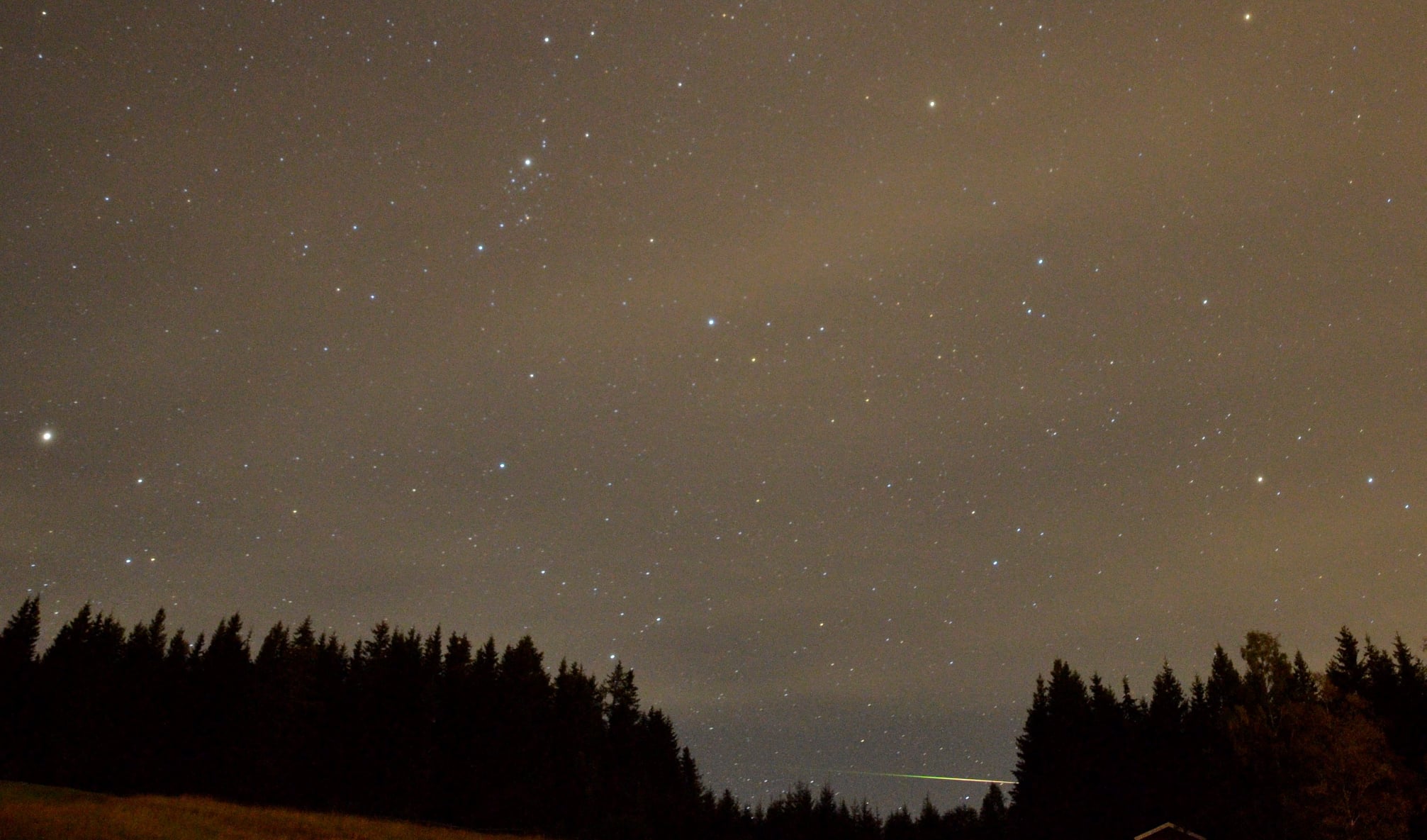
Figure 1. A magnitude -4 Aurigid fireball, photographed August 31, 2021 at 21h34m UT. Photographer: Kai Gaarder from southern Norway.
Abstract
August 2021 turned out to be a special month for meteor observers. During this month, three meteor showers showed increased activity: the Perseids showed a strong and unexpected outburst with a ZHR of 195 ± 20 on August 14 (Jenniskens 2021a and Miskotte, 2021), the kappa Cygnids showed increased activity as expected (Jenniskens, 2021b), and the Aurigids showed a short outburst as expected on August 31 (Ogawa 2021). In this article the results are presented, based on calculations using visual observations of the Aurigids in 2021.
Introduction
The Aurigids are a minor meteor shower with fast meteors (66 km/s) that have their maximum around August 31, usually with a ZHR of 5. In the past this meteor shower has shown several small outbursts, including in 1994 and 2007. In (Rendtel, 2019), a nice overview has been given. In 2019, the Aurigids showed another short outburst with a ZHR of 62 ±12 at λʘ = 157.918° (August 31, 2019 21h22m UT) (Rendtel, 2019). The outburst was also detected with radio and video observations. Based on model simulations, another outburst was predicted on August 31, 2021 between UT 21h and 22h UT. Indeed, the Aurigids displayed a moderate outburst once again, this article gives the results of the analysis.
Predictions
For 2021, independent predictions from different modelers, Jeremy Vaubaillon, Mikiya Sato, and Esko Lyytinen (†2020) were available. All modelers found a very short distance between the Earth and the dust trail. Determining the expected maximum ZHR turned out to be somewhat more difficult, because of the assumed ejection rates of the particles from the parent body. The expected maximum ZHR would be somewhere between 50 and 100.
Table 1. Predictions for the Aurigids in 2021.
Distance λʘ Date and time
- Sato 00054 AU λʘ = 158°,383 2021 Aug 31, 21h17m UT
- Lyytinen 00017 AU λʘ = 158°,395 2021 Aug 31, 21h35m UT
- Vaubaillon 0001 AU λʘ = 158°.396 2021 Aug 31, 21h35m UT
The times shown in Table 1 were especially favorable for Asia and eastern Europe, but the problem was that the Moon around the maximum was also above the horizon and even near the radiant. The problem for European observers was the very low radiant position, but they had the advantage that the Moon would only rise roughly a half hour after the expected maximum.
Which data to use?
Looking at the website of the International Meteor Organization for data from the Aurigids, it appeared that it would be a difficult analysis. This is mainly due to the low radiant heights, although this has the advantage for visual observers that more earthgrazers can be seen. In standard ZHR analyses, calculations are usually made, only for observations with a minimum radiant height of 25 degrees. The data available on the IMO site was obtained with radiant positions between 3 and 15 degrees during the period of maximum activity.
Former experience with very low radiant positions learned that computing ZHRs only gives a somewhat reliable results if an observer has a reasonable number of shower meteors, the limiting magnitude is high and a good Cp determination is available from the observer. According to the data on the IMO website, 240 Aurigids were counted by 36 observers over the entire Aurigid period (August 30 to September 7, 2021). During the maximum, 129 Aurigids were seen. The IMO on the fly curve shows a nice activity profile, with an assumed population index r of 2.2 with minimum limiting magnitude 5.0. A maximum was found at λʘ = 158.381° (2021 August 31, 21h17m) with a ZHR of 74 ± 20. See Figure 2.
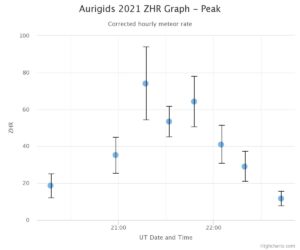
Figure 2. On the fly curve on the IMO website of the Aurigids during maximum activity. See: https://www.imo.net/members/imo_live_shower?shower=AUR&year=2021. This image was generated on September 12, 2021 at 09h45m UT.
Because the above graph has been generated using most data with a limiting magnitude of 5.0 or better, the author decided to do an analysis based on more restricted conditions. The data was selected using the following criteria:
- An observer must have observed at least 8 Aurigids during the maximum period.
- The minimum limiting magnitude is 6.0 or better.
- No minimum radiant height was set due to the very limited data set.
- Data must be supplied in short counting periods around the maximum.
- Sky obstruction percentages up to a maximum of F=1.10.
- A reliable CP must be known from the observer.
- The periods with 0 detections of the selected observers were also included in the calculations.
Unfortunately, of the 35 observers, only 5 observers remained, who collectively observed 87 Aurigids.
Population index r
To determine the population index, the data must meet certain requirements. These are:
- The limiting magnitude must be rounded to a minimum of 6.0.
- The difference between the limiting magnitude and the mean magnitude of the meteor shower should be less than 4 magnitudes.
71 Aurigids met the criteria described above and the population index r was determined on the basis of this set. The dataset was too small to calculate a gradient. What the visual observers described is correct, relatively many Aurigids from –1 to +1 were seen. This, of course, results in a low population index r. Table 2 is the result of the population index r calculations.
Table 2. Population index r Aurigids on 31 August 2021.
|
r |
|
|
r[–2;+5] |
2.03 ± 0.27 |
|
r[–1;+5] |
1.90 ± 0.27 |
|
r[–1;+4] |
1.58 ± 0.30 |
|
r[ 0;+4] |
1.6 ± 0.32 |
|
r[ 0;+5] |
2.04 ± 0.29 |
|
r[ +1;+5] |
2.34 ± 0.32 |
For the ZHR calculations the range r[–1;+5] was used, with a population index r = 1.90.
Zenital Hourly Rate (ZHR).
With the calculated population index r, the ZHR could be calculated. The ZHR is calculated using the following formula:

The radiant height correction exponent γ was set to 1. This surprisingly yielded a very nice result, see Table 3 and Figure 3. However, this result should be interpreted with caution because:
- The observations were made with very low radiant heights between 3 and 20 degrees, see also the large error bars in the graph (Figure 3)
- The ZHR curve is based on only 87 Aurigids.
- Because the counting periods stated by the observers varied quite a bit (between 9 and 15 minutes), weighted average ZHRs were used.
- Overlapping periods have been calculated.
Table 3. ZHR of the Aurigids on August 31, 2021 between 19 and 23 UT.
|
Time UT |
λʘ (°) |
Periods |
AUR |
ZHR |
Dev |
r[-1;5] |
Observers |
|
19.834 |
158.324 |
2 |
2 |
27.1 |
19.2 |
1.9 |
2 |
|
20.167 |
158.337 |
3 |
3 |
27.0 |
15.6 |
1.9 |
3 |
|
20.375 |
158.345 |
4 |
3 |
24.3 |
14.0 |
1.9 |
4 |
|
20.694 |
158.358 |
3 |
3 |
33.9 |
19.6 |
1.9 |
3 |
|
20.859 |
158.365 |
5 |
3 |
34.9 |
20.1 |
1.9 |
4 |
|
21.013 |
158.371 |
6 |
6 |
28.5 |
11.6 |
1.9 |
4 |
|
21.133 |
158.376 |
6 |
15 |
72.8 |
18.8 |
1.9 |
5 |
|
21.264 |
158.381 |
7 |
20 |
90.6 |
20.3 |
1.9 |
4 |
|
21.364 |
158.385 |
8 |
22 |
84.4 |
18.0 |
1.9 |
4 |
|
21.509 |
158.391 |
8 |
20 |
74.8 |
16.7 |
1.9 |
4 |
|
21.633 |
158.396 |
7 |
14 |
60.1 |
16.1 |
1.9 |
5 |
|
21.749 |
158.401 |
8 |
12 |
36.4 |
10.5 |
1.9 |
6 |
|
21.868 |
158.406 |
6 |
6 |
21.4 |
8.7 |
1.9 |
4 |
|
22.006 |
158.411 |
6 |
12 |
48.3 |
13.9 |
1.9 |
6 |
|
22.108 |
158.415 |
4 |
12 |
68.3 |
19.7 |
1.9 |
4 |
|
22.208 |
158.419 |
3 |
8 |
50.9 |
18.0 |
1.9 |
3 |
|
22.406 |
158.427 |
3 |
4 |
18.2 |
9.1 |
1.9 |
3 |
|
22.489 |
158.431 |
3 |
5 |
21.4 |
9.6 |
1.9 |
3 |
|
22.663 |
158.438 |
3 |
6 |
25.1 |
10.2 |
1.9 |
3 |
|
22.724 |
158.440 |
2 |
3 |
19.1 |
11.0 |
1.9 |
2 |
|
22.919 |
158.448 |
3 |
3 |
8.6 |
5.0 |
1.9 |
3 |
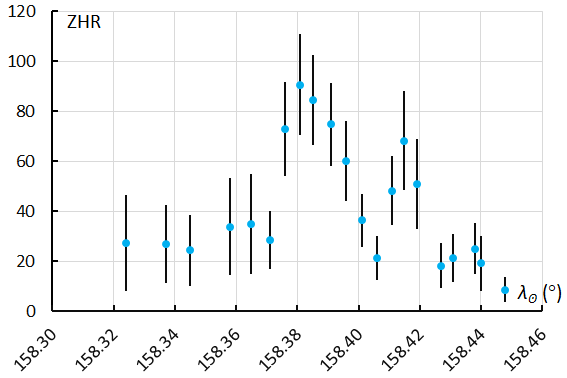
Figure 3. ZHR profile Aurigids on August 31, 2021 based on 87 Aurigids.
The ascending wing to the peak shows a kind of a plateau between λʘ = 158.324° and 158.372° (this is on August 31, 2021 between 19h50m and 21h00m UT) with an average ZHR of 30. After that a double peak is clearly visible is at λʘ = 158.381° (August 31, 2021 at 21h16m UT) and λʘ = 158.415° (August 31, 2021 at 22h06m UT). This was already somewhat visible in the IMO curve (Figure 2), but has now been extended somewhat. The second peak of the IMO on the fly curve also is slightly earlier than that of this analysis. Indeed, most observers temporarily see fewer meteors between λʘ = 158.40° and 158.41° (August 31, 2021 between 21h45m and 22h00m UT). After the second peak there is again a kind of (short-lived) plateau with ZHRs 20–25 between λʘ = 158.427° and 158.440° (August 31, 2021 between 22h25m and 22h45m UT) after which a further decline seems to occur.
A nice independent analysis has now also been published in WGN of the IMO (Rendtel, 2021). Slightly different parameters were used in this and a minimal number of Aurigids was not considered. The limiting magnitude was set at 5.5. A population index r with r = 1.65 was found. This is lower than found in this analysis with an r = 1.90. The result of these calculations is shown in Figure 4. The maximum was found at λʘ = 158.384°, ie 2021 August 31, 21h18m UT with a maximum ZHR of 74 ± 17. The ZHR is also somewhat lower than found in this analysis, so probably also some other parameters should be considered such as more 0 detection intervals and the lower population index r. The second peak in the IMO analysis is considerably lower than that found in this analysis (ZHR 33 instead of 68). The reason for this is that in the IMO analysis more observers were used who registered also more 0 detection intervals.
It is unfortunate that the email addresses of observers submitting data to the VMDB are unknown to the author. Some of the data in this analysis was not used due to excessively long observation periods and the author could have contacted the relevant observers to ask for shorter counting intervals.

Figure 4. ZHR profile of the Aurigid outburst based on visual observations sent to the VMDB.
Some observers provided shorter counting periods than visible in the VMDB upon request.
Finally, the visual data that came in before and after the maximum night was also used for analysis. Because of the disturbing Moon, all observations with radiant heights of 10 degrees or higher were used. The result is shown in Figure 5. It appears that the Aurigids still showed some above-normal activity on September 1 and 2 with ZHRs of 8 and 11, respectively.
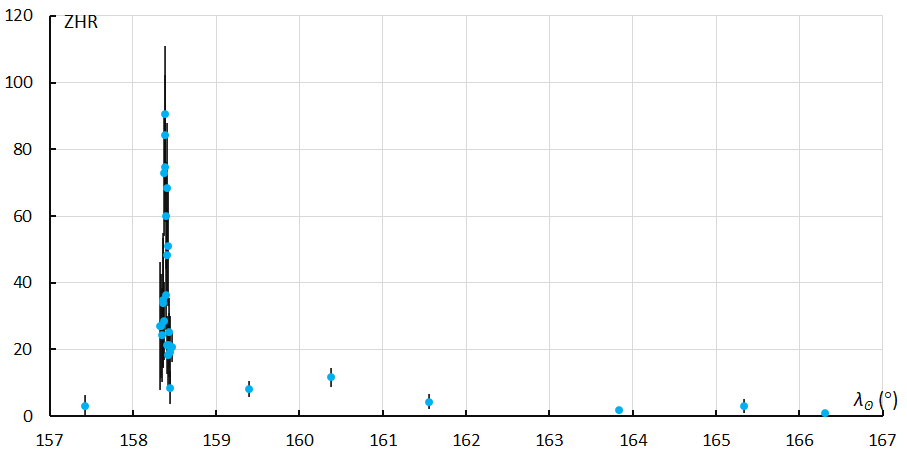
Figure 5. The activity of the Aurigids between August 30 and September 9, 2021.
Comparison with radio observations
Thanks to Hiroshi Ogawa and Hirofumi Sugimoto, the author received the radio observations (ZHRr) from Japanese radio observers based on 10-minute counts (Ogawa, 2021). The way in which Sigumoto determines his ZHRr is described in (Sugimoto H., 2017). Some of the data overlaps with the visual data used in the above analysis. Figure 6 shows the result.
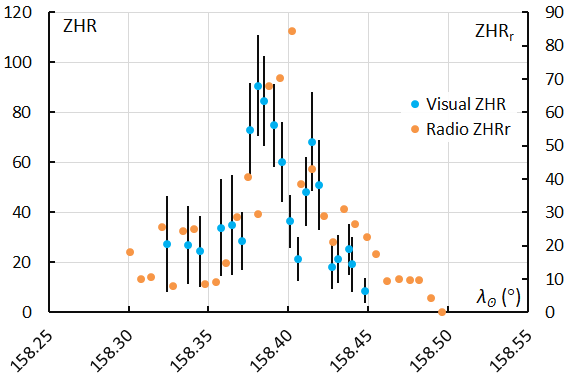
Figure 6. Visual (ZHR) and radio (ZHRr) observations combined in one figure.
This shows that there is a reasonably good agreement between the two graphs. In any case, it shows that the ZHR curve based on visual observations, despite the low radiant positions, is quite reliable. The visually observed maximum was at λʘ = 158.381° (August 31, 2021 at 21h16m UT) and with radio at λʘ = 158.402° (August 31, 2021 at 21h45m UT). Thus, the visual 1st maximum is close to the time predicted by Mikiya Sato (August 31, 2021 at 21h16m UT), while the radio peak and the second visual peak are closer to the predicted time by Esko Lyytinen and Jeremy Vaubaillon. But of course, we also have to bear in mind that the results of the models with only an 18-minute interval are very close to each other. The radio data also shows a second peak around the second visual peak. However, the “dip” between the two radio “peaks” is much less deep than the “dip” between the visual peaks.
Conclusion
All in all, a nice result considering that the observations were made with very low radiant heights. Good Cp determinations and observations done under good conditions are then very important. Comparison with radio observations gives good overall agreement, but in details there are still differences (such as time of maximum). The low number of Aurigids used in this analysis may explain these small differences.
Acknowledgment
Thank you very much, to all observers who observed the Aurigids in 2021. These are: Mark Adams, Lucas Camargo da Silva, Mykhailo Chubarets, Kai Gaarder, Christoph Gerber, Sietse Dijkstra, Simon Dijkstra, Matthias Growe, Lumír Honzík, Glenn Hughes, Antal Igaz, Javor Kac, Carl Johannink, Václav Kalaš, André Knöfel, Selma Koelers, Jiri,Konecny Ralf Koschack, Hynek Krejzlik, Lukas Krejzlik, Katerina Krumpholcova, Jens Lacorne, Robert Lunsford, Miloslav Macháček, Oleksandr Maidyk, Fabrizio Melandri, Koen Miskotte, Veikko Mäkelä, Tomáš Nejdl, Jonas Plum, Ina Rendtel, Jurgen Rendtel, Stefan Schmeissner, Ivan Sergey, Ulrich Sperberg, Ondřej Trnka, Dita Větrovcová, Michel Vandeputte, Thomas Weiland, Roland Winkler and František Šesták.
Also, a word of thanks to Carl Johannink, Michel Vandeputte (for critical reading and for providing suggestions on the article), Hiroshi Ogawa and Hirofumi Sugimoto (for providing the radio observations) and Paul Roggemans for checking my English.
References
Ogawa, H., Sigumoto H. (2021). “Aurigids (AUR#00206) 2021 using worldwide radio meteor observations radio results 2021”. eMetN, 6, in press
Jenniskens P., Miskotte K. (2021a). “Perseid outburst”. eMetN, 6, 460–461.
Jenniskens P. (2021b). “Enhanced κ-Cygnid (KCG#0012) activity in 2021”. eMetN 6, 462–463.
Miskotte K., Sugimoto H., Martin P. (2021). “The Big surprise: a late Perseid outburst”. eMetN, 6, in press
Rendtel J., Lyytinen E., Vaubaillon J. (2019). “Enhanced activity of the Aurigids 2019”. WGN, Journal of the IMO, 48, 258–262.
Rendtel J., Koschack R. (2021). “Letter — Aurigid outburst on 2021 August 31”. WGN, Journal of the IMO, 49, 73–75.
Sugimoto H. (2017). “The New Method of Estimating ZHR using Radio Meteor Observations”. eMetN, 2, 109–110.






